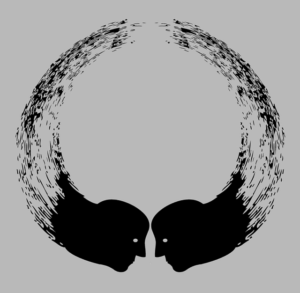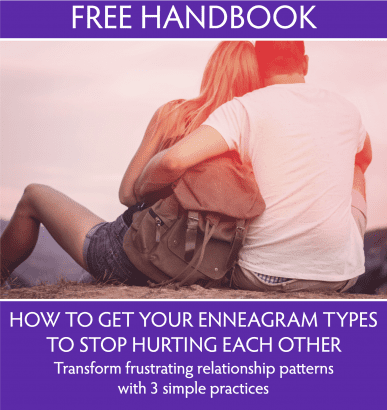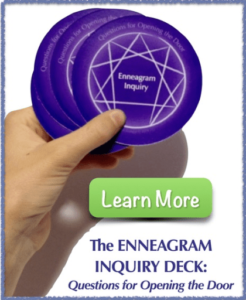* An Enneagram Burning Question *
How do I deal with the negative or down sides of my enneatype?
I ask this because I used to think that mine was such a great number to be (I realize the irony here). And now I struggle with the negative aspects of being my type. What are ways I can be kinder to myself about the negatives? And how can I work to bring out the positives? — J, type 9
Dear J,
What a poignant question! In a way, this is everyone’s question when we learn the Enneagram and begin to see the “high” and “low” sides of our types showing up in life. Tracking the ways our type operates is definitely worthwhile in building consciousness about how we impact ourselves and others. It helps us see when and how our type can be a real blessing to others and when it gets in the way. And it helps us realize, bit by bit, that we are not truly who we’ve taken ourselves to be (this is a good thing!).
Let me start with some framing before I offer suggestions about how to work with your question.
When is Type an Obstacle?
Expressing the best and/or avoiding the worst of our types is more an outcome of using the Enneagram for transformation than the goal of it. The goal is to stay present with ourselves with whatever is arising in the moment. When we learn to do this more, we can discern better about when our type’s gift is what is truly needed in the moment, and when it is simply our autopilot insisting on itself again.
Noticing when my type is not working for me can help me recognize that my soul is not congruent with this rigid form that tells me who I must or must not be, or how I must or must not act. When I tell myself: “I must be the high side of type” or “I must not be (or show) the low side of my type,” I ironically reinforce the rigidity of the pattern rather than loosening it.
Our enneatypes are more than nine arbitrary machinations from old survival strategies, however. As delivery systems of distinct aspects of our nature, they have the potential to bring real value, diversity, and help to the world. In our type “specializations” we can minister to one another. This is most likely to happen when our type is not in the driver’s seat, however.
When we are in touch with Presence, the best of us becomes more accessible. When we are grounded in the present and open to what is arising, we are likely to show up with the high side of our type, and also may show up as “beyond” our type in some ways.
This state offers a quality of flow, responsiveness and freedom that is, in my experience, far more delightful and meaningful than when my Nine is doing its thing in a way that others appreciate or that my inner critic approves of.
Softening the Type’s Grip
Paying attention to how our types show up in us over time helps to soften the rigidity of the personality structure, allowing it to become less dominant or “thick.” As your type becomes more translucent, the light of your soul or true nature can shine through more fully. When this happens you may find yourself more able to intelligently respond to what’s arising here and now.
A friend of mine (type 8) had passion about what she wanted to pursue next in her career, but not much sense of what the needed steps would be. She talked about it with her friend (type 3) who was able to effortlessly rattle off a clear and effective step-by-step plan for her. The Eight was stunned at the Three’s ability to automatically unfurl a strategic path, and found it a real gift. It was indeed a gift because it was what was wanted in the situation. If the Three had rolled out the action plan for how her friend should leave her husband when she wasn’t ready to, it would have been insulting.
As a Nine myself, I have gotten feedback about how my style can be a gift in putting others at ease, how they appreciate my grounded, accepting presence. And of course this can be a real asset in certain situations- like when there is a need to slow down and get receptive. In mainstream US culture, however, this same trait can be seen as a liability— as not being productive or active enough. And some enneatypes can find the Nine’s calm stance threatening- like when Nine tries to keep everything calm and “easy” when the other is experiencing danger or distress.
Ultimately, I want to not have to blindly obey the dictates of my program. If I’m a Five, for example, I want to have the freedom to move toward as well as away from others. Yet my program’s strong bias toward keeping distance can leave me feeling estranged.
Or as type Six, when I am identified with my personality, I am likely to unconsciously obey the programs of doubt and faith in ways that are quite different from how I would respond if I were grounded in Presence in the moment.
Downsides as Doorways
I’m excited that you’ve paid enough attention to your pattern that you can actively see the downsides of your type. This means you have developed more potential to loosen the knots that lead you down the same old paths all the time and face the next layers in store for you. This is really powerful! We can lose sight of the power of it though, because it’s usually uncomfortable to confront the non-preferred parts of us.
The key is to not identify with the downsides, to judge them, or to take them to be the “bad you.” For example, a Two who is in “doormat” mode isn’t a “bad” Two, he just may be feeling conflicted, suffering, and at the mercy of his type pattern. He is simply disconnected from Presence and therefore from what is needed in the situation.
Another tricky piece is when we are positively identified with a type-behavior or perception that impacts ourselves or others negatively. As type Four, for example, I can derive benefit from a melodramatic interpretation of my life. I might enjoy the passion, intensity and the push-pull with others that makes me feel alive or cared about. After a while, however, many Fours grow weary of this approach and its outcomes, yet still have a hard time choosing something else. Or as type Seven, I love my positivity— it is my life-raft and I don’t want to set it down for fear of being swamped.
Critic Watch
Seeing the downsides of our type gives us leverage in our development if we can avoid falling into the traps of our inner critic. We must learn to identify and then separate from the commentary or attacks of the critic, otherwise all our Enneagram insights can be turned against us to make us feel more trapped instead of more free.
Freeing ourselves from the tyranny of this aspect of mind is a big topic. A great resource to revisit many times is Byron Brown’s book Soul Without Shame: Freeing Yourself from the Judge Within. Suffice it to say, liberating ourselves is not a one-time task. But every little bit more space we get internally is radically worth the devotion and repetition.
I can easily use the Enneagram as tool of judgment against myself, such as: “I’m so distracted! I can’t even remember to do my awareness practices!” When you witness yourself in the downside of type, and it feels discouraging or like a dead end, you could entertain the notion that the distress you feel may actually be a doorway to what you need.
For example, as type One, when I notice I feel tight, resentful or righteous, I could receive that experience as a bell ringing which means, “Oh dear! I’ve lost contact with Presence and ground again. Sweetness is nowhere to be found. Let me help myself come back home.” I could receive the tension in my body as a siren song beckoning me back to compassionate contact with myself, my humanity, my needs.
I can’t effectively make this turn without accessing that grounded, loving presence, however.
Kindness as Key
I especially like the part of your question about how to be kinder to yourself when you notice your pattern showing up. This, I think, is most important after noticing.
There are a couple of types of kindness that may be needed. First, there is kindness toward the whole proposition that I have a type structure and that it keeps derailing me from how my soul wants to be.
David Daniels suggests forgiving ourselves simply for having our pattern yet again (and again) by “befriending our reactivity.” If we think having a few powerful insights will undo a lifetime of survival structure, we are holding unrealistic expectations for ourselves.
Secondly there is often a more specific kindness needed toward the parts of us who are afraid or in pain. When you’re stuck in your pattern, look for the part of you who is longing for kindness– the one who is hurt by being told she doesn’t matter or is not good enough, etc. Visualizing or directly sensing in your body this aspect of you who is being dismissed, bullied, or rejected often makes it easier to find her and turn toward her.
Opening to Presence
Starting with feeling our suffering, we can then feel our need for support or kindness. We can’t make ourselves feel supported or kind, but we can choose to open to the possibility of support and kindness coming through us.
Our level of suffering can be seen as correlated with our level of identification with our personality and to our experience of being disconnected from Presence. Riso and Hudson’s Levels of Development can be seen as a map of our experience depending on how close to or far from Presence we are.
“…the lack of Presence, the lack of awareness of what one was doing and feeling in the here and now, was the primary way by which one became trapped in increasing identification with the images and defenses of the ego structures.”
So when you notice the downsides showing up, let this awareness ring as a reminder that you’ve lost contact with Presence, and that it’s time to find your way back, with the help of your inner observer, through your breath and body.
Practices to Open to Presence
For all enneatypes, there are some simple steps we can take to open to the Presence that wants to animate us. They are “simple” in that they are not complicated, but that does not mean it is easy to remember or choose to employ them.
- Notice your experience of a habitual pattern of sensation, emotion or thought, and choose to pause and come home to yourself.
- Contact your experience in the present moment.
- Follow your breath in and down into your core to abide with yourself.
- Directly sense your feet and legs. Focusing on our sensations helps us anchor into the present moment and softens the insistent mental-emotional looping. Focusing on our feet and legs offers a direct sense of grounding necessary to support starting with our struggles.
- Open to your experience with curiosity about what your sensations might be communicating to you and how they are affecting you. If you get pulled off into habitual loops or self-criticism, come back to steps 1 and 2.
- Respond to your experience in the moment with compassion. This may be simply acknowledging your own struggle in a supportive way, deciding to ask for help, communicating your needs to a trusted someone, or choosing to do something expressive or soothing for your body. The needed response in the moment is unique and personal.
For Type Nine Specifically
In addition to these general practices, here are a few specific strategies that can support type Nine’s opening to Presence.
- For Nines, a major obstacle can be wanting to show up for our experience at all— it can be uncomfortable when there’s been a habit of trying to keep things mellow since our inner lives can have lots of intensity to them. Appreciate the courage it can take to actively witness or engage your process even for a few moments. After awhile you’ll find that the water isn’t as icy as you’d feared
- When you catch yourself in self-forgetting, conflict avoidance, or telling yourself you don’t matter, see if you can celebrate the catch! “A-ha! There it is again!” Consider the pattern as an old dog in you who is just following its old training. With love, remind your faithful companion that you will guide it in a new way and it can stay close by your side.
- Find simple ways to care for yourself each day. The importance is not which actions you choose, as much as it is in the tone and transmission of real care. For example, you could:
- Simply brush your hair or make your breakfast with loving kindness, or
- Take yourself for a walk where instead of running lists or drifting off, you accompany yourself as you would a friend- enjoying your body sensations and attending to your experience
Remember: your soul does not need mitigating or improving. Your personality is just a vehicle and shining it up won’t get you more satisfaction. Your true nature is full of capacity and wisdom.
The main task is simply noticing when something’s getting in the way of that wisdom, and using that as a harbinger to come back home to reconnect.
Thanks so much for your question, J!










2 Responses
I love these blogs. Thank-you
I’m glad they are helpful to you!